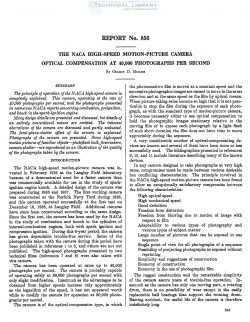naca-report-856

- Version
- 146 Downloads
- 1.78 MB File Size
- 1 File Count
- August 31, 2016 Create Date
- August 31, 2016 Last Updated
National Advisory Committee for Aeronautics, Report - The NACA High Speed Motion Picture Camera Optical Compensation at 40,000 Photographs Per Second

The principle of operation of the NAOA high-speed camera is
completely explained. This camera, operating at the rate of
40,000 photographs per second, took the photographs presented
in numerous NAOA reports concerning combustion, preig-nition,
and knock in. the spark-ignition engine.
M'any design details are presented and discussed, but details of
an entirely conventional nature are omitted. The inherent
aberrations of the camera are discussed and partly evaluated.
The focal-plane—shutter eject of the camera is explained.
Photographs of the camera are presented. Some high-speed
motion pictures of familiar objects—photoflash bulb, firecrackers,
camera shutter—are reproduced as an illustration of the quality
of the photographs taken by the camera.
The NACA high—speed motion-picture camera was in-
vented in February 1936 at the Langley Field laboratory
because of a demonstrated need for a faster camera than
was commercially available for use in the. study of spark-
ignition engine knock. A detailed design of the camera was
prepared during 1936 and 1937. The first working camera
was constructed at the Norfolk Navy Yard during 1938,
and this camera operated successfully at the first test on
December 16, 1938, at Langley Field. Additional cameras
have since been constructed according to the same design.
Since the first test, the camera has been used by the NACA
in the study of combustion and knock in the cylinders of
internal-combustion engines, both with spark ignition and
compression ignition. During this 6—year period, the camera
has given dependable trouble-free service. Some of the
photographs taken with the camera during this period have
been published in references 1 to 6, and others are not yet
published. The high-speed photographs presented in two
technical films (references 7 and 8) were also taken with
this camera.
The camera has been operated at rates up to 40,000
photographs per second. The camera isprobably capable
of operating safely at 80,000 photographs per second with
only slight modification. Inasmuch as the advantages to be
obtained from higher speeds increase only approm’mately
as the logarithm of the speed, it has not appeared worth
while to modify the camera for operation at 80,000 photo-
graphs per second.
| File | Action |
|---|---|
| naca-report-856 The NACA High Speed Motion Picture Camera Optical Compensation at 40,000 Photographs Per Second.pdf | Download |

Comment On This Post